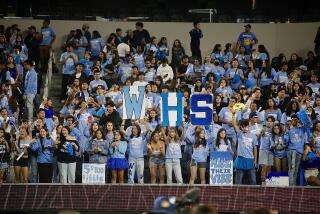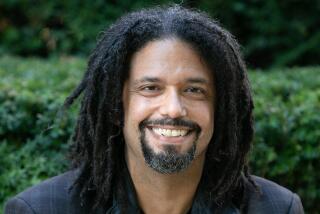Time for a football stadium deal
Ever since the Los Angeles Raiders took their ball and went home to Oakland in the mid-1990s, Los Angeles has waged an intermittent and sometimes half-hearted campaign to lure the National Football League back to the city, by far the nation’s largest without a football team. That effort has been marked by exuberance and disappointment, misdirection and considerable public indifference. As the City Council takes the measure of a new proposal to construct a football stadium downtown, it should recall that history in full — realizing that the city’s future does not depend on whether the NFL plays here, but also appreciating that it should not let the most promising football deal it has ever received slip through its fingers because it was too slow or too political to reason effectively.
While safeguarding the city’s interests, the council should, over the next few weeks, do what it often finds difficult: act decisively, in this case to approve a memorandum of understanding with AEG, the Denver-based sports and entertainment group, and allow the stadium to move forward.
What’s in it for L.A.?
Although some residents have long been eager for football to return, the quest for a local team has failed to engage many others who care little about the sport and have plenty of options to entertain themselves. The conventional draw for a team — the desire for the prestige it would confer — has been notably absent here. But if Los Angeles doesn’t need the prestige of a team, it does have other reasons to want this deal. AEG and its chief executive, Tim Leiweke, have revitalized the south end of downtown with their phenomenally successful Staples Center and adjoining LA Live. Once a collection of dilapidated buildings and parking lots, the area now is a hub of sports, entertainment, restaurants and hotels, as vibrant late at night as it is during the day. The stadium would build on that with an arena large enough to hold events as diverse as Pac 12 football, the Final Four, soccer and major concerts.
That means jobs — not just temporary construction jobs but also permanent positions at the stadium as well as at the stores, restaurants and hotels that this project is expected to attract. And with those jobs would come tax revenue for the city, county and schools, benefits that even the least passionate sports fan can appreciate.
There is an additional aspect of this project that makes it more attractive than other recent football proposals. It promises not only a team and the development that accompanies it, but the rescue of a stranded civic facility, the beleaguered Los Angeles Convention Center. As envisioned by AEG and Leiweke, the new stadium would sit on the land now occupied by the center’s West Hall. That hall is aging and unworkable, disconnected from the newer, larger South Hall. For it to be functional and appealing, the city estimates that it needs $80 million worth of improvements. Instead, AEG proposes that the new stadium replace the West Hall and link up to the South Hall, creating a vast, contiguous convention space — enough to attract the very large conventions that are today out of Los Angeles’ reach.
Then there is the tax revenue the project is expected to generate. Today, the city barely breaks even on the operations of the convention center and is saddled with more than $45 million of annual debt service on the South Hall. If the stadium is built, one consulting firm hired by AEG predicts that it would spur development of 3,064 new hotel rooms, which would nearly double the tax revenue currently generated by existing hotel rooms downtown. That analysis suggests an additional $26 million to $33 million in bed taxes for the city; it also estimates that the increase in convention business from major conventions alone would produce an additional $228 million in annual spending — with the state and local governments getting their share of that in taxes. If those estimates hold, then, the city would not only get a new convention center but would be able to pay off its existing one.
That by itself is reason to support this proposal.
What should the council look out for?
The proposed stadium turns on a paradox: If AEG manages only to run it as a football stadium — with 10 to 12 games a year, mostly on Sundays — the effect on traffic and parking downtown would barely be felt. But if AEG maximizes its potential by holding more events, and thus delivering more in jobs and taxes, then its negative effects would escalate as well. In other words, the more successful the facility is, the more it may inconvenience residents. The council should recognize that conundrum and insist on the rigorous analysis that will flesh out the implications of the project.
Where it gets even more complicated is in AEG’s plans for boxing or wrestling or the Final Four. Those events and others like them take place at all hours and would put real stress on the area’s already groaning road network. Recognizing that, AEG has grand dreams of bolstering the public transportation options around LA Live and of hosting the first Super Bowl in history at which most fans arrive on foot, either from nearby hotels or from train stations or shuttles. It’s the council’s duty to see that those plans are not just selling tools but real proposals cemented in the ultimate deal, with AEG bearing its share of the responsibility for planning and funding them.
AEG is also seeking protection from the California Environmental Quality Act, which allows those affected by projects — including, in some cases, competitors — to file lawsuits blocking them. AEG is hardly the only entity to protest some of CEQA’s more permissive litigation rules, and a wholesale review of the act is not only in order but in fact underway in Sacramento. If those negotiations result in constructive CEQA reform that helps AEG, so much the better. That said, AEG does not deserve its own environmental law. It should, as it has promised, complete an environmental impact report for the project, and neither the city nor state should exempt it from the rules that apply to others.
Finally and most important, the city needs to be a vigilant guardian of the public purse. The estimates for this project appear to pencil out favorably for the city, but officials need to recall that the convention center once looked like a good investment too. As part of this deal, the city would get new taxes generated by the nearby hotels, stores and restaurants. But it would give up much of the property and sales taxes generated by the new stadium itself (the county and state would keep their share) and allow that money to pay off the bonds used to finance construction. City officials need to see that the government coffers are protected in return.
Initially, AEG proposed taking over the city land beneath the West Hall for $1 a year, on the theory that it was also taking on the responsibility of renovating that hall for the city’s benefit. As negotiations have progressed, the two sides now are talking about AEG paying fair-market value for the land. That’s appropriate.
The state of play
Earlier this month, Leiweke told Los Angeles Times reporter Sam Farmer that he was losing patience with the City Council, and indicated he was getting ready to walk away. “I’m OK if we get to July 31 and we don’t get a deal done,” he said. “We move on.” Leiweke’s apparent imposition of an ultimatum was unseemly — he’s already seen by many to wield outsize influence at City Hall — but his impatience is understandable. Los Angeles is an infamously difficult place to pull off a large project.
The council doesn’t do anything fast. And, in this case, it’s dealing with a project of considerable complexity and uncertainty. It should protect the environment, look for ways to make sure that traffic and parking problems are anticipated, and make AEG pay its share of a project that will reap significant returns. And it should do so quickly.
The construction of a football stadium — or the failure to build it — will not alter the essence of Los Angeles. What AEG has built downtown is no more an expression of Los Angeles than the company’s nearly identical KC Live is of Kansas City. These are centers of commerce and entertainment, not culture. Indeed, they come at some cost to culture, as a new stadium will draw business from both the Los Angeles Coliseum and Pasadena’s Rose Bowl, authentic monuments to the region’s history.
But that history also includes a healthy appreciation for the new, an embrace of commerce and even glitz. A new stadium may create traffic snarls, but so do Dodger Stadium and the Los Angeles Times Festival of Books. Residents complain but grudgingly accept that the area’s most appealing attractions come with caveats. And in return, this deal promises jobs, tax revenue and the revitalization of a city asset.
The recent images of the mayor and council members rushing to have their pictures taken with Leiweke did not inspire confidence that the city would strike a hard bargain. Since then, however, the negotiations have sweetened and clarified the benefits. Now, it’s incumbent on the city’s leadership to quit dawdling, focus on their obligation to the public, and cut the deal.
More to Read
A cure for the common opinion
Get thought-provoking perspectives with our weekly newsletter.
You may occasionally receive promotional content from the Los Angeles Times.










